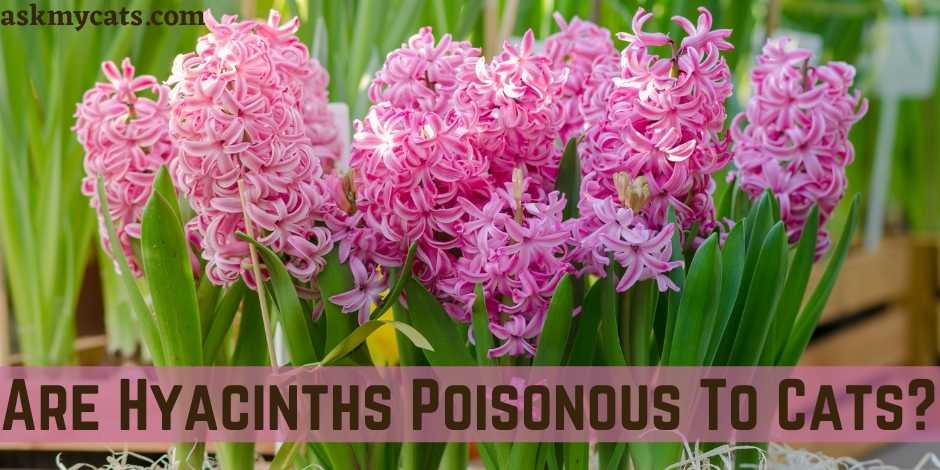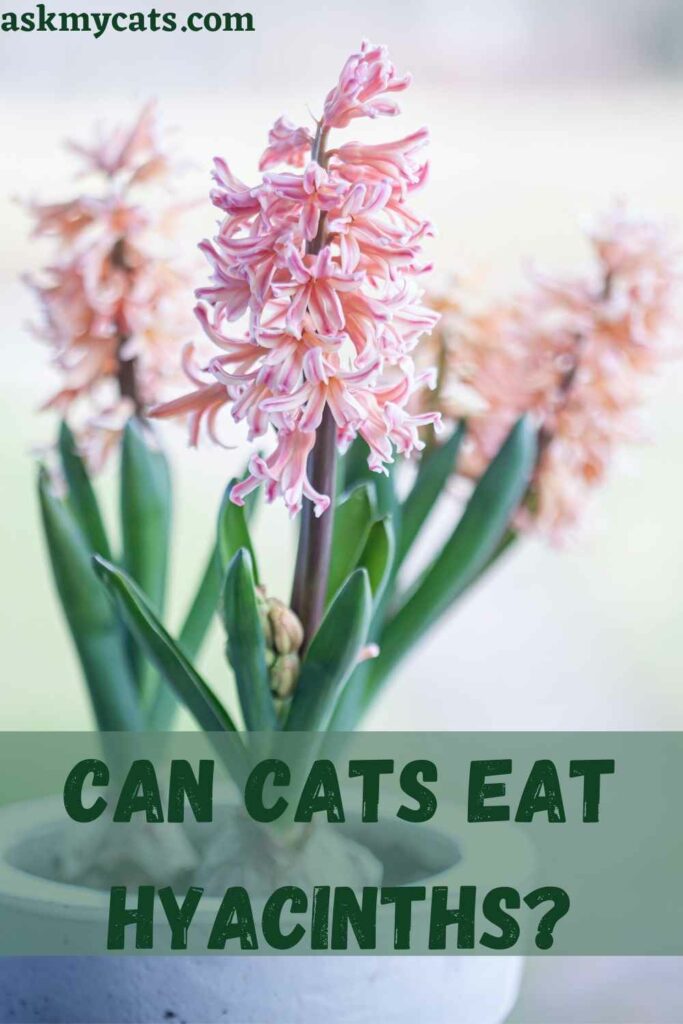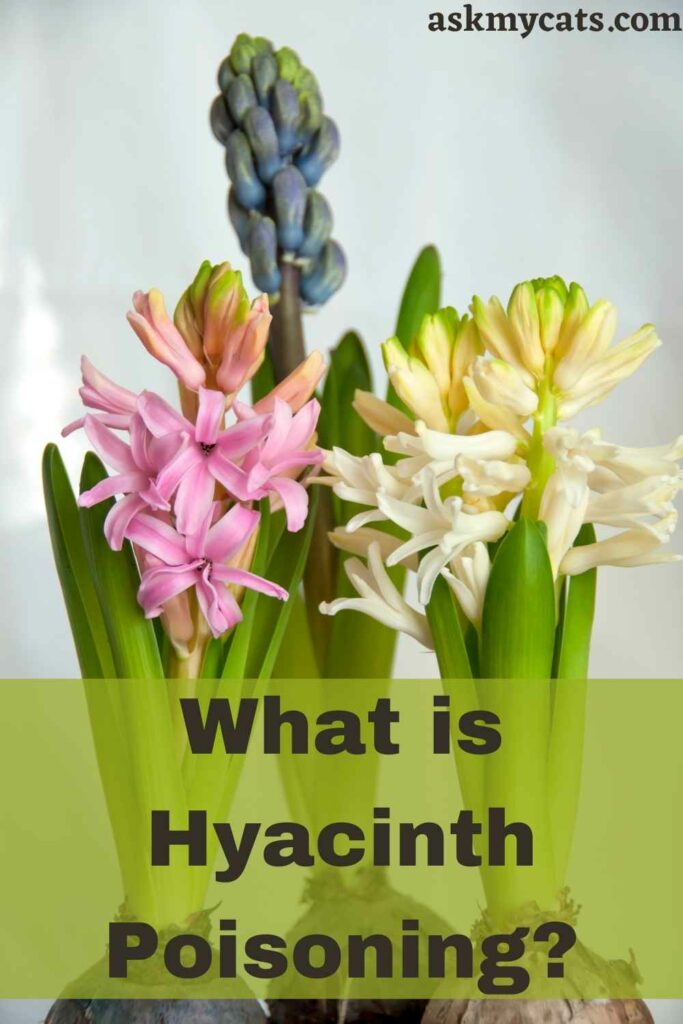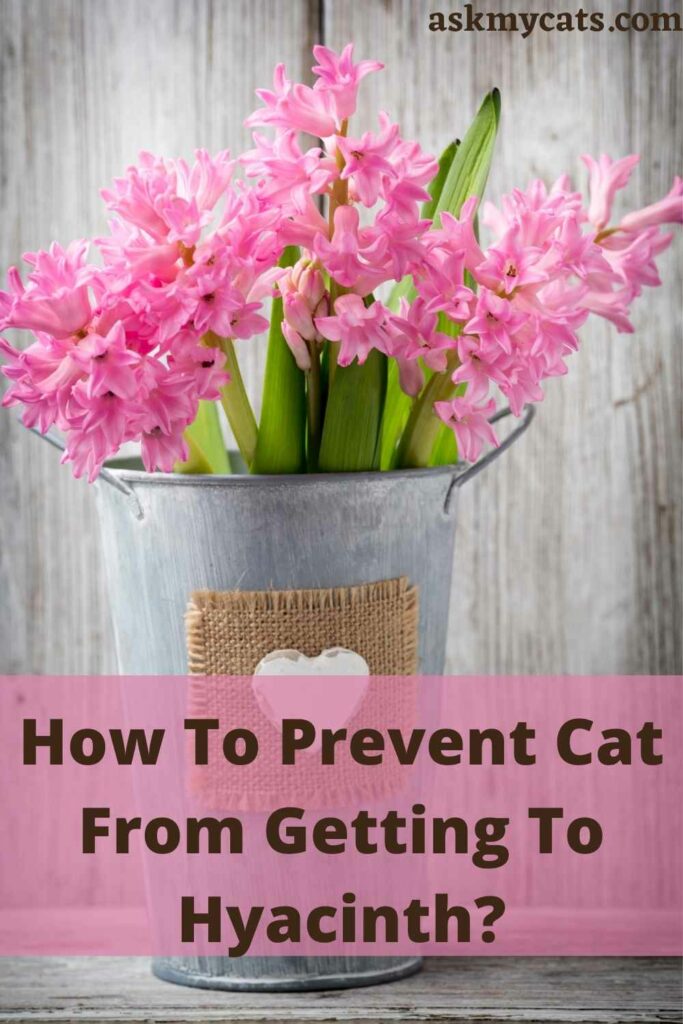Plants and flowers may instantly brighten a room or add colour to a landscape, but they can also be toxic. If swallowed, some plants are poisonous and harmful to cats.
Hyacinth is the name given to ornamental garden and house flowering plants in the Hyacinthus genus of the Asparagaceae family (formerly family Liliaceae). They have fragrant, dense-spiked flowers in a variety of colours, including deep purple, pink, white, red, yellow, lavender, blue, and apricot, that grow on bulbs.
Finally, this plant has green leaves and bulbs that resemble onions or shallots that are partially exposed.
So, is hyacinths poisonous to cats?
Yes, hyacinths are poisonous to cats. Cats, other animals, and even humans get poisoned by hyacinths. Poisonous stems, leaves, blooms, and bulbs, with the bulbs being the most dangerous.
This article will tell you that why hyacinths are poisonous to cats and how to keep cats away from hyacinths.


Give Your Cat the Perfect Day
Get the Free Ebook!
What Is Hyacinths?
Hyacinth, (genus Hyacinthus) is a small genus of bulbous herbs (family Asparagaceae, formerly Hyacinthaceae), native primarily to the Mediterranean region and tropical Africa.
Hyacinthus orientalis is the source of the ordinary garden hyacinths, which are popular spring ornamentals.
The subterranean bulb of most species produces four to six short untoothed leaves. The inedible bulbs contain oxalic acid, which can irritate the skin.
The very fragrant blossoms are normally blue, but developed versions might be pink, white, or other colours.
Each flower stalk has a little bract (leaflike structure) below it, and the flowers are borne in a raceme cluster at the apex of the leafless stems.
Ornamental cultivars’ flowers are frequently densely arranged, whereas wild species’ inflorescences can have as few as two or three flowers.
The eastern Mediterranean region, which includes Turkey, Turkmenistan, Iran, Iraq, Lebanon, Syria, Israel, and Palestine, is home to the Hyacinthus genus.
It has been widely naturalized in other parts of the world, including the Netherlands, France, Sardinia, Italy, Sicily, Croatia, Serbia, Montenegro, Bulgaria, North Macedonia, Albania, Greece, and Cyprus, Korea, North America (the United States and Canada), central Mexico, Cuba, and Haiti.
The oxalic acid in hyacinth bulbs makes them toxic. Hyacinth bulbs can cause minor skin discomfort when handled. Gloves for protection are recommended.
Some members of the plant subfamily Scilloideae are popularly referred to as hyacinths, despite the fact that they are not members of the genus Hyacinthus and are edible; one example is the tassel hyacinth, which is eaten in some Mediterranean nations.
Can Cats Eat Hyacinths?
No, cats cannot eat hyacinths as they are poisonous.

According to the Illinois University Library, the main cause of toxicity in these ornamental plants is oxalic acids, notably “calcium oxalate raphides,” as well as the presence of “alkaloids such as lycorine.” Lactones that cause allergies are also a common cause.
Oxalic acid, as you may know, causes calcium oxalate crystals in cats, as well as kidney damage, decreased urine production, calcium-binding, and hypocalcemia (low calcium), among other symptoms.
Toxicity can be caused by eating, inhalation, or contact with the skin.
Hyacinth leaves, blooms, stems, and bulbs that are frequently exposed from the ground may be ingested or dug up by your cat.
Topical contact causes mild to moderate skin irritation, itching, or redness. Your cat may experience blisters in rare instances.
If breathed by susceptible cats, it can cause nasal irritation, breathing difficulties, wheezing, coughing, and other allergy symptoms.
Hyacinths are members of the Liliaceae family, and they contain allergic lactones or alkaloids. When taken in significant amounts, the poisonous component of this plant is concentrated in the bulbs (rather than the leaf or flower) and can cause severe clinical symptoms.
When cats dig up newly planted bulbs or get access to a large bag of them, they can become severely poisoned from hyacinth or tulip poisoning.
Chewing or ingesting the plant parts or bulbs can cause tissue irritation in the mouth and throat. Depending on the amount ingested, symptoms may include excessive drooling, vomiting, or even diarrhoea.
More severe symptoms, such as an increase in heart rate, changes in respiration, and trouble breathing, may be noted with large ingestions.
If your cat or kitten has ingested any part of this ornamental plant, talk to your vet for further diagnosis and treatment.
What is Hyacinth Poisoning?
When the calcium oxalate present in hyacinth causes pain and inflammation, it is known as hyacinth poisoning.

The bulbs of the hyacinth pose a concern to cats because they contain high levels of poisons.
Allergenic lactones, lycorine alkaloids, and calcium oxalate raphides are among these poisons.
Internal or external discomfort is frequently caused by allergenic characteristics.
The calcium oxalate raphides include a lot of sharp crystals that, once released, get stuck in the cat’s oral and oesophagal tissues, causing pain and inflammation.
These bulbs are bright in colour and can kill cats if they are eaten.
Hyacinths are a type of bulbous plant that can be found throughout North America. They are classified as “Hyacinthus orientalis” and belong to the Liliaceae plant family.
Hyacinths are well-known for their clusters of brightly coloured blossoms that bloom in the early spring.
Flowers in blues, purples, pinks, yellows and whites grow in bunches on stalks. The flower has a trumpet or bell-like appearance and is quite fragrant. The leaves have a meaty look and are frequently thin in shape.
Plants such as hyacinths are not cat-friendly. Hyacinth plants will not harm your cat, but they will make life difficult for them. The toxin within can become a more serious condition if left ignored.
These plants should be kept away from all pets, including dogs, cats, small pets, and birds.
What Are Symptoms Of Hyacinth Poisoning?
The symptom of hyacinth poisoning in most cats is a mild to moderate reaction. If a considerable section of the bulb has been consumed, severe instances can occur. If the cat has touched the plant, it may cause skin irritation. The following are all warning signs to look out for: –
- Nausea
- Vomiting
- Diarrhea (may contain blood)
- Excessive drooling
- Oral irritation
- Pawing at the mouth
- Depression
- Increased heart rate
- Rapid or difficult breathing
- Tremors
Many gardeners adore hyacinths, and as a result, they are commonly found growing in residential areas.
The plant is also frequently marketed in a pot for indoor use. This means that hyacinths may be encountered by both indoor and outdoor cats at some point in their lives.
Because the poisons are concentrated in the bulbs, cats who dig up plants are at a far higher danger of ingesting the deadly parts of the plant.
This is not a common occurrence among cats, but it is not unheard of. When chewed, the plant causes pain and irritation in the mouth, thus most cats don’t eat much of it.
How To Diagnose Hyacinth Poisoning In Cats?
You can diagnose hyacinth poisoning in cats by keeping an eye out for initial symptoms and taking your cat to the vet.
If you are concerned about your cat’s health or if severe symptoms concerning breathing and heart rate have begun to develop, bring it in for a professional evaluation.
If the cat’s essential functions need to be stabilized, treatment may begin before a diagnosis is made.
If you see your cat eating plant material and aren’t sure what it is, bring a small clipping to the vet for identification. Giving your cat’s complete medical history can also help them obtain the care they need.
The cat will be given a thorough physical examination to identify any symptoms that have appeared.
Blood samples from your cat will be used for routine tests. A full blood count and a biochemical profile are usually included in these assays.
Urine samples may also be analyzed to see if the kidneys or liver have been harmed, which is common with calcium oxalate toxicity.
In severe circumstances, the veterinarian may listen to the cat’s heartbeat and respiration and detect irregularities.
How Treat Hyacinth Poisoning In Cats?
You can provide treatment of hyacinth poisoning in cats by: –
1. Activated Charcoal
This can be used to help absorb and contain all toxins in the stomach, allowing them to pass through the body undigested.
2. Supportive Care
Supportive care may include monitoring the cat’s heart and breathing during the incident, depending on the cat’s condition.
Certain drugs can be used to help the cat’s heartbeat return to normal. If the cat is dehydrated, intravenous fluids may be administered. During this time, the cat will need to be hospitalized.
3. Remove Plant Material
This may entail washing the cat’s mouth to eliminate any residual plant material and calm the oral cavity’s inflammation.
Your veterinarian may use hydrogen peroxide to make your cat puke. To eliminate all of the contents of the stomach, gastric lavage may be used.
This may entail cleaning the cat’s mouth to eliminate any residual plant material and relieve oral irritation.
Your veterinarian may provide hydrogen peroxide to make your cat puke. To eliminate all of the contents of the stomach, a gastric lavage might be used.
How To Prevent Cat From Getting To Hyacinth?
You can prevent your cat from getting to your hyacinth plants by trying out these easy yet effective steps: –

1. Citrus
Citrus is a natural odour that cats despise. To keep your cats from getting too close, place orange or lemon peels around the tops of your pots.
You can also keep them away by sprinkling orange, apple, or grapefruit rinds within your potted plants.
2. Coffee Grounds, Sawdust, and Pine Needles
Coffee grounds are also unappealing to cats. To deter cats, scatter used coffee grounds at the base of your plants.
Pine needles are another fantastic alternative for décor because they have a natural look and stop cats from digging up your plants.
To keep cats away from your pots, sprinkle sawdust at the base of your pots if you have an outside compost.
3. Vicks VapoRub
Vicks VapoRub is a natural insect repellant that contains camphor and eucalyptus oils. In fact, many experts swear by this method to keep cats away from their potted plants.
Smear a coating of the ointment around the top and base of your pot. Your cats will be unable to jump in and dig up the dirt as a result of this.
4. Peppermint Oil
Peppermint oil is another natural repellent. Because cats are extremely sensitive to this aroma, rubbing a little on your potted plants should suffice to solve your problem.
5. Cat Repellent Sprays
There are more conventional techniques to repel your cats if you don’t want to go the natural route.
It’s a two-in-one product that may be used to clean your house and leaves an unpleasant orange-coconut aroma that cats dislike.
Simply wipe down the outsides of your plant pots with your preferred home cleaner, and your cats will keep clear.
Frequently Asked Questions
Is Hyacinth poisonous to kittens?
If a cat consumes a big amount of the hyacinth bulb, the effect might be lethal. Hyacinth poisonings are uncommon, although they do occur. Due to their small stature and high levels of curiosity, kittens are the most vulnerable. Keep this plant out of reach of your cat. To keep your cat from devouring hazardous plants like the hyacinth, it’s best if you don’t let it outside.
How to take care of hyacinth?
Hyacinth should be grown in large groupings for the greatest and farthest-reaching aroma. Because hyacinths come in so many colours and sizes, they go well with other spring-blooming bulbs—their spiky flower stalks contrast nicely with cup-shaped tulips and ruffled daffodils. Hyacinth bulbs come in a wide range of sizes. Plant hyacinth bulbs in the fall, six to eight weeks before the first frost, for spring garden blossoms. They should be planted 4 to 6 inches deep, root end down (widest side down). Allow them to spread out a little by spacing them 3 to 6 inches apart. Cover with soil and give it plenty of water. Taller types have a tendency to flop; if you only have a few, stake them or plant them closer together so that they support one other.
Is grape hyacinth safe for cats?
Grape hyacinth, bluebells, and Muscari are summer-blooming bluish-purple flowering decorative plants for the lawn, garden, or container. These blooms have an urn shape and create grape-like bunches. Muscari species with edible bulbs, such as tassel grape hyacinths (Leopoldia comosa), should not be mistaken with Hyacinthus species, which have toxic bulbs. While both belong to the Scilloideae subfamily, their genera are distinct. Grape hyacinth is not harmful to cats, therefore it’s a good choice if you want blooms from the Scilloideae subfamily.
Final Words
If you have this or any other hazardous plant in your garden, lawn, or containers, apply safe repellents, cage container flowers, cat-proof your garden and yard, and so on to keep your feline friend out of them. Wear gloves when handling them because they will cause slight discomfort to your skin if they come in contact with it.
If you have any queries, please leave them in the comments section.
